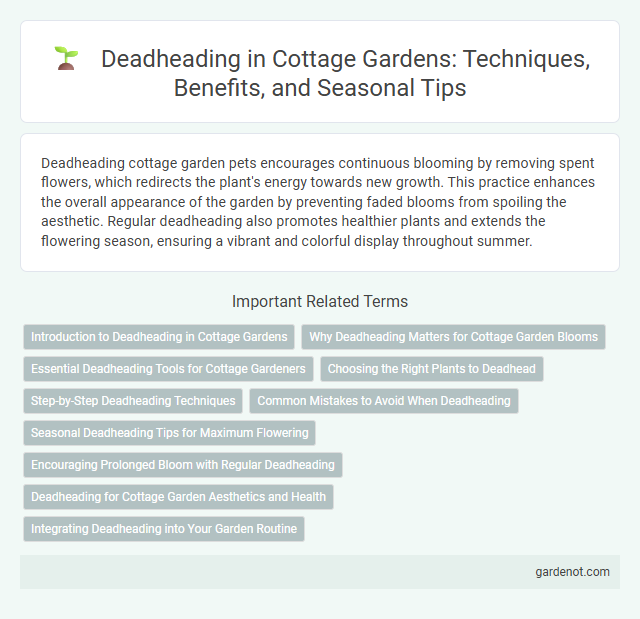Deadheading cottage garden pets encourages continuous blooming by removing spent flowers, which redirects the plant's energy towards new growth. This practice enhances the overall appearance of the garden by preventing faded blooms from spoiling the aesthetic. Regular deadheading also promotes healthier plants and extends the flowering season, ensuring a vibrant and colorful display throughout summer.
Introduction to Deadheading in Cottage Gardens
Deadheading in cottage gardens involves the regular removal of spent flowers to encourage continuous blooming and maintain plant health. This practice helps redirect the plant's energy from seed production back into flower development, resulting in a more vibrant and extended flowering season. Commonly deadheaded plants in cottage gardens include roses, hollyhocks, and daisies, which thrive with timely maintenance for optimal display.
Why Deadheading Matters for Cottage Garden Blooms
Deadheading is essential for sustaining vibrant blooms in a cottage garden by preventing spent flowers from diverting energy into seed production. Removing wilted blossoms encourages plants like roses, hollyhocks, and foxgloves to produce more flowers, extending the blooming season. This practice enhances the overall aesthetic appeal and promotes healthier, more vigorous growth in classic cottage garden plants.
Essential Deadheading Tools for Cottage Gardeners
Essential deadheading tools for cottage gardeners include sharp pruning shears, hand scissors, and garden gloves that ensure precise removal of spent blooms without damaging surrounding foliage. A clean, rust-free blade is crucial for healthy cuts that promote vigorous flower growth and prevent disease spread in dense cottage garden settings. Incorporating a small bucket or garden waste bag helps maintain tidiness by collecting clippings efficiently during deadheading sessions.
Choosing the Right Plants to Deadhead
Choosing the right plants to deadhead in a cottage garden involves selecting species that benefit most from the practice, such as roses, daisies, and geraniums, which promote extended blooming periods and improved plant health. Deadheading these plants prevents seed formation, directing energy into new flower growth and maintaining the garden's aesthetic appeal. Understanding each plant's growth cycle ensures timely deadheading, maximizing flowering potential and vibrant garden displays.
Step-by-Step Deadheading Techniques
Deadheading cottage garden flowers involves promptly removing spent blooms to encourage continuous flowering and prevent seed formation. Begin by using clean, sharp scissors or pruning shears to cut just above the first set of healthy leaves or a new bud, ensuring a clean cut that stimulates new growth. Regularly inspect plants for wilted flowers and maintain this practice throughout the growing season to maximize bloom production and garden vitality.
Common Mistakes to Avoid When Deadheading
Deadheading in a cottage garden enhances bloom longevity and plant health but common mistakes such as removing buds prematurely or cutting too close to the main stem can hinder growth. Failing to sanitize pruning tools can spread diseases among plants, while neglecting to deadhead regularly allows spent flowers to set seed, reducing overall flowering vigor. Proper deadheading techniques, including identifying which flowers to remove and using sharp, clean tools, ensure continuous blooming and a thriving cottage garden environment.
Seasonal Deadheading Tips for Maximum Flowering
Deadheading regularly in a cottage garden encourages continuous blooming by removing spent flowers and redirecting the plant's energy towards new growth. Focus on timing seasonal deadheading by pruning spring-flowering perennials immediately after they bloom, while summer and fall bloomers benefit from deadheading throughout their flowering period. Consistent removal of dead flowers helps maintain plant health, enhances garden aesthetics, and maximizes overall flowering potential.
Encouraging Prolonged Bloom with Regular Deadheading
Regular deadheading removes spent flowers from cottage garden plants, preventing seed formation and redirecting energy toward new blooms. This practice significantly extends the flowering period, enhancing garden vibrancy throughout the growing season. Consistent deadheading of species like roses, daisies, and foxgloves promotes continuous floral display and maximizes garden aesthetics.
Deadheading for Cottage Garden Aesthetics and Health
Deadheading promotes continuous blooming and maintains vibrant colors in a cottage garden by removing spent flowers promptly. This practice prevents seed formation, allowing plants to conserve energy for new growth and enhancing overall garden health. Regular deadheading also deters disease and keeps the garden tidy, supporting the classic, lush appearance of a traditional cottage garden.
Integrating Deadheading into Your Garden Routine
Integrating deadheading into your garden routine enhances plant health by promoting continuous blooming and preventing seed formation. Regular removal of spent flowers encourages energy redirection towards new growth, optimizing flower production throughout the season. Incorporate deadheading tools such as sharp garden scissors or pruners to maintain clean cuts and minimize plant stress effectively.
Deadheading Infographic

 gardenot.com
gardenot.com